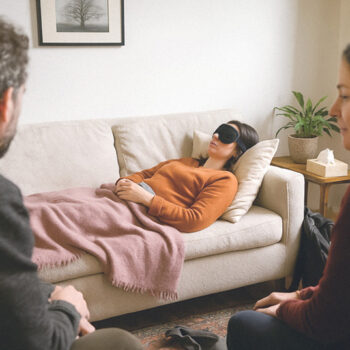The Benefits of Sound Therapy
When sound becomes a form of care, sound therapy invites us to reconnect with the original frequency of our well-being.

Sound therapy (or sound healing) invites us into a mystical knowledge that echoes the origins of life. Its aim is as simple as it is profound: to bring well-being through sound vibrations that stir the emotions.
Music is part of our daily lives. After a busy day or while walking in the street, we use it to calm ourselves or to isolate from the world. From the beginning of time, sound has always played a role. Vibrations awaken something within us that soothes or connects us. Through the maternal womb, our first perception of the world is essentially vibrational. Across cultures, percussion has been a social binder: by the fire, during life’s rituals, or even on the battlefield.
The use of sound for healing is not new. The practice of sound healing is rooted in the great shamanic traditions of India and Tibet, with equivalents found everywhere—from Afghanistan to ancient Greece. It is safe to say that sound healing is both ancient and universal.
What is Sound Therapy?
A sound therapy session offers a gentle and deeply soothing immersion designed to harmonize the body and mind. In an intimate setting, dim lighting and the subtle fragrance of essential oils create a relaxing ambiance. Participants settle comfortably, lying on a mat or seated, wrapped in a light blanket, ready to surrender to the experience.
The practitioner uses a palette of instruments with varied tones that seem to resonate in the quietest corners of the soul. Each sound acts as an invisible thread, guiding the listener into a meditative state where time appears to stand still. Tensions gradually dissolve, replaced by a sense of lightness and connection.
When the final notes fade, a new silence emerges, carrying the imprint of this sonic interlude. Slowly, the body reawakens, and consciousness returns, accompanied by a feeling of clarity and balance. The practitioner offers a moment of exchange to discuss sensations and impressions.

The Instruments
Drums, gongs, didgeridoos, and singing bowls—the instruments of sound healing resonate with deep tones, akin to whale songs. They are particularly rich in harmonics, enabling them to act on various waves coursing through the body.
Tibetan singing bowls induce a state of deep relaxation. They influence brainwaves and soothe the nervous system. Similarly, tuning forks help eliminate energy blockages. Tuning fork therapy is often used to relieve pain and balance emotions.
Among the most majestic instruments in sound therapy is the gong. The power of a gong bath envelops the entire body in a sea of deep vibrations, while chimes with their crystalline notes evoke the gentle caress of wind on water.
During a session, these instruments are placed near the participant so that vibrations can penetrate deeply and act on different dimensions of being. Certain frequencies target the physical body, others the nervous system, and others still the emotions. These profound and powerful waves ripple through the body, soothing it entirely.
This is referred to as sound healing when one experiences physical or psychological improvement.
A Tibetan Singing Bowl Workshop
What are the benefits of sound therapy?
Sound healing is not a medical discipline; it is a holistic relaxation practice whose mechanisms remain largely unknown. However, science acknowledges its health benefits, similar to breathwork. Several studies confirm that vibrational sounds influence our organs and central nervous system.
When absorbed by the body, certain frequencies possess therapeutic properties, both physically and psychologically. They can nourish and harmonize the electromagnetic field, fostering relaxation and calm. This effect reduces stress, releases tension, enhances memory, concentration, creativity, and even sleep quality.
During a sound therapy session, participants may experience several states, including:
- Stress reduction, letting go, and deep relaxation.
- Release of physical and emotional tension and blockages.
- Stimulation of the immune and lymphatic systems.
- Chakra cleansing and energy balance stabilization.
- Improved flow of vital energy.
- Introspection and reconnection with one’s true essence.
The Principle of Sound Healing
The Original Vibration
In sound therapies, it is believed that all living beings—and even the universe—vibrate at specific frequencies. These frequencies can become unbalanced due to stress, illness, or lifestyle.
The method seeks to restore the optimal frequency for normal functioning. It is akin to tuning an old radio, adjusting the dial to find the right frequency for clear reception.
To recalibrate, the body is exposed to vibrations, often produced by low-pitched percussion instruments. These sounds are deep, intense, and slow-paced.
The Impact of Sound on the Human Body
Physiologically, our bodies naturally house a set of vibrational cords: the nerves. One of them, the vagus nerve, governs our emotions. Connected to the parasympathetic nervous system, it extends from the head to the abdomen, passing through the cranium, heart, and intestines.
When we receive specific sounds, particularly deep and strong tones, they stimulate the parasympathetic nervous system, which then signals the organs to enter a state of rest and regeneration.
Supporting this, several studies show that sound vibrations have a calming effect, reducing cortisol levels (the stress hormone).
Water and Cells
Another hypothesis, albeit unproven, connects the water in the human body to vibrational sounds. Japanese author Masaru Emoto believed that sound waves could influence the shape of frozen water crystals. According to him, vibrations associated with positive words created harmonious shapes, while negative waves distorted them. The purity of a vibration could potentially restructure the water in our cells and enhance regeneration.
While this theory resonates with ideas about water memory, no experiment has successfully reproduced or validated these findings. Belief remains a personal choice.
Rediscovering Simplicity
We know little about the cellular impact of sound therapy. Does it matter? There’s no need to seek explanations at all costs, especially if it means mimicking science.
What truly matters is that this holistic practice offers unique sensations. They are undeniable for those who experience them. More importantly, they bring well-being, which is paramount.
Sound healing taps into emotions beyond words, in a purely instinctive realm. It reconnects us to our bodies and a primordial state, reminding us that we are sensory beings. Sensitive beings who must find their way back to the simplest, most profound experiences.
What Are the Contraindications of Sound Healing?
Sound healing has very few constraints. There is no risk of a “bad trip,” and it can be practiced by anyone—children, adults, and even babies—provided the intensity of the vibrations is adjusted. However, there are a few contraindications: this practice is not recommended for women in the first four months of pregnancy or individuals with pacemakers.
What Is Binaural Beats Therapy?
Binaural beats therapy involves using slightly different frequencies in each ear, creating a beat perceived by the brain. These binaural beats may help synchronize brainwaves, promoting relaxation, meditation, or states of enhanced focus and concentration.
What Is a Gong Bath?
A gong bath immerses participants in the resonant sounds of the gong, creating a meditative and deeply relaxing environment. The sound waves produced by the gong may penetrate the body, supporting physical healing, emotional release, and mental clarity. It is a popular form of group sound therapy.
Is Sound healing a Psychedelic Experience ?
No, sound therapy is not psychedelic; it is deeply relaxing. For this reason, it is often used before ceremonies involving magic mushrooms or shamanic Ayahuasca journeys. It helps participants relax, providing a calmer and safer foundation for their spiritual experience.
Image de freepik et alexeyzhilkin
Last updated on 5 December 2024





